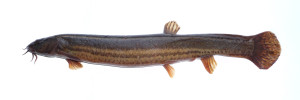 This loach has a black-rippled yellowish brown back, yellow belly – even reddish at times, with three lengthwise black stripes on the sides, with the middle one much broader than the other two; all its fins are brown with black ripples. Albino loaches can also be encountered. This loach inhabits rivers with swamped banks and sluggish water, backwaters of large rivers, slow creeks, lakes and ponds with mud bottoms, and often in boggy ditches absolutely unfit for any other fish – even the crucian. Loaches keep to the bottom, often digging up in ooze, and forage on bottom invertebrates: wrigglers and other larvae, bottom cladocera and small clams. The ability to live in waters with low oxygen content can be explained by the well-developed additional organ for air-breathing – a small tract of the end gut profusely laden with blood vessels. In low-oxygen water the loach surfaces from time to time, swallowing a bubble of air and exhausting through its anus another bubble, which has already gone through the digestive tract yielding oxygen to blood. When swallowing air, it makes a noise comparable to a squeak – it becomes much audible when holding a loach. This is why the fish is sometimes referred to as the squeaker. In low atmospheric pressure loaches rise to the surface. This behavioral change during pressure drops has been long noted by man and used to predict weather. For this purpose the loaches are specially kept in small tanks.
This loach has a black-rippled yellowish brown back, yellow belly – even reddish at times, with three lengthwise black stripes on the sides, with the middle one much broader than the other two; all its fins are brown with black ripples. Albino loaches can also be encountered. This loach inhabits rivers with swamped banks and sluggish water, backwaters of large rivers, slow creeks, lakes and ponds with mud bottoms, and often in boggy ditches absolutely unfit for any other fish – even the crucian. Loaches keep to the bottom, often digging up in ooze, and forage on bottom invertebrates: wrigglers and other larvae, bottom cladocera and small clams. The ability to live in waters with low oxygen content can be explained by the well-developed additional organ for air-breathing – a small tract of the end gut profusely laden with blood vessels. In low-oxygen water the loach surfaces from time to time, swallowing a bubble of air and exhausting through its anus another bubble, which has already gone through the digestive tract yielding oxygen to blood. When swallowing air, it makes a noise comparable to a squeak – it becomes much audible when holding a loach. This is why the fish is sometimes referred to as the squeaker. In low atmospheric pressure loaches rise to the surface. This behavioral change during pressure drops has been long noted by man and used to predict weather. For this purpose the loaches are specially kept in small tanks.
Spawning in spring, they lay eggs in their regular habitats by shores and in thickets, and besides, they often travel far inland in floods, leaving their fry far from lakes and rivers.
The species is internationally red-listed.
/ * The photos at lake.peipsi.org are cross-posted from commons.wikimedia.org and are used for familiarization purposes only. No commercial use of the photos is allowed. For more information about to use the photos see the originals on commons.wikimedia.org. /


